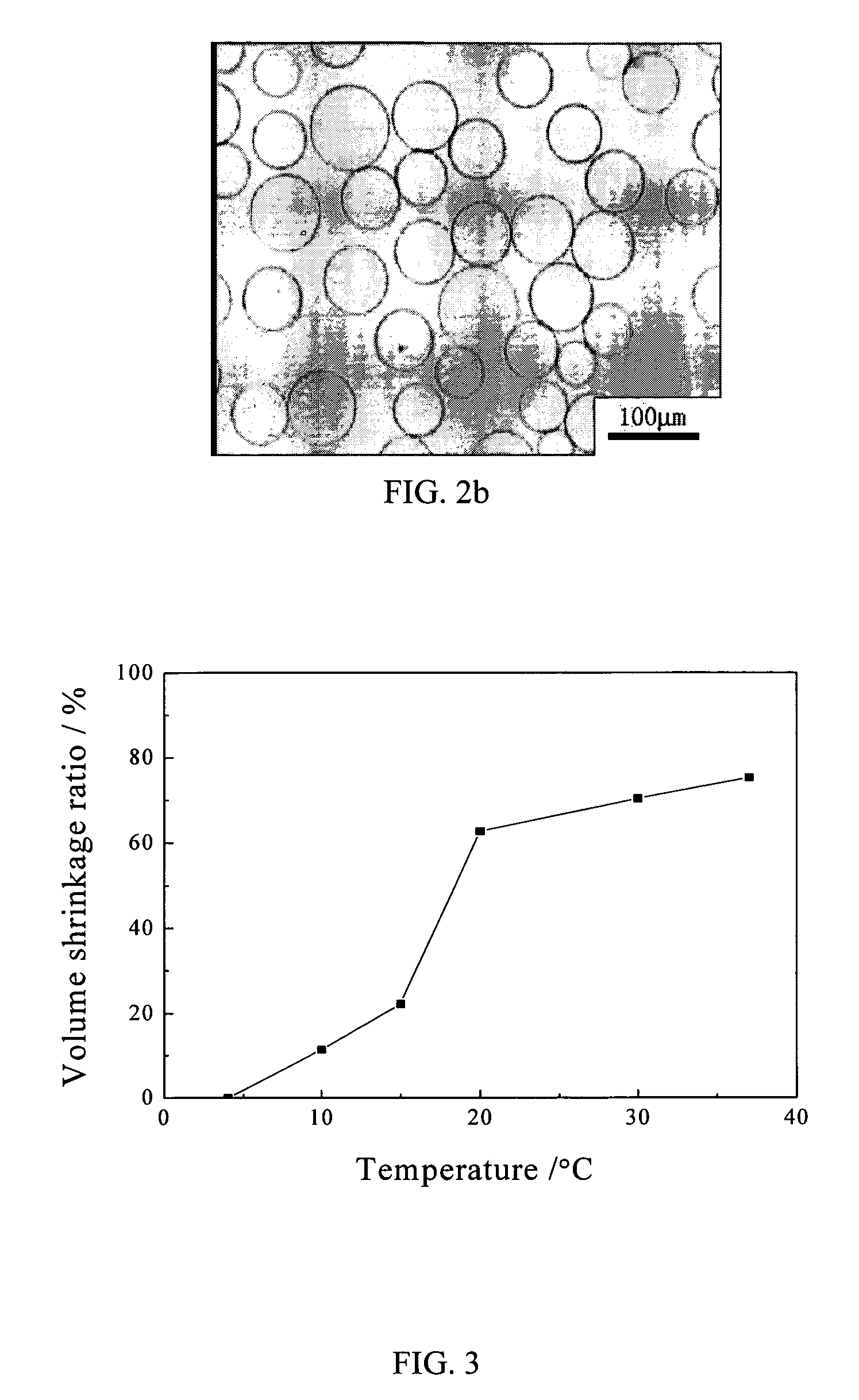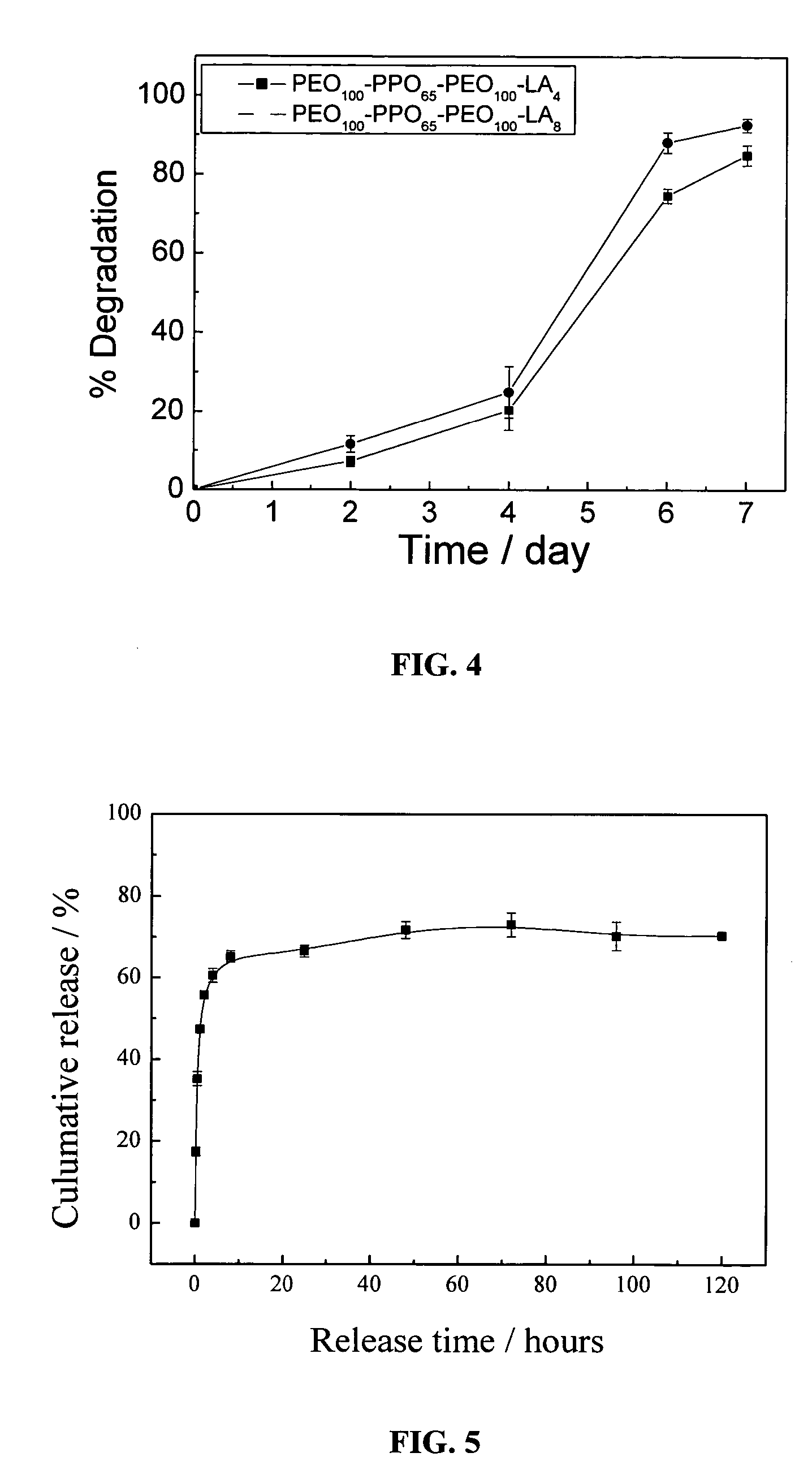Thermosensitive and biodegradable microgel and a method for the preparation thereof
- Summary
- Abstract
- Description
- Claims
- Application Information
AI Technical Summary
Benefits of technology
Problems solved by technology
Method used
Image
Examples
example 1
Preparation of a Macromer
[0090]A 50 ml ampoule was flame dried under vacuum. 20 g of PEO100-PPO65-PEO100 (the number in the subscript denotes the associated averaged degree of polymerization), 0.92 g of l-lactide and 1.3 ml of 10 mg / ml stannous octoate toluene solution were charged into the tube. After mixing the contents well, the tube was preheated to 60° C. for 6 hours under repeated cycles of vacuum and drying in argon or nitrogen to remove any volatile materials. The tube was then sealed off under vacuum (0.1 mmHg) and the mixture was copolymerized at 140° C. for 24 hours. The resultant copolymer was dissolved with dichloromethane, then precipitated with excess anhydrous ether (−10˜0° C.), and recovered by filtration. The dried copolymer was then used for subsequent reactions. Other polymers were similarly synthesized using d,l-lactide or ε-caprolactone and calcium hydroxide in place of glycolide and stannous octoate and different PEO-PPO tri-block copolymers with different rat...
example 2
[0096]The procedure employed is similar to that in Example 1. After a 50 ml ampoule was flame dried under vacuum, PEO129-PPO56-PEO129, ε-carprolactone and stannous octoate were charged into the tube (the molar ratio of three components is 1:8:0.02). After the contents were well-mixed, the tube was preheated to 60° C. for 6 hours under repeated cycles of vacuuming and drying with argon or nitrogen to remove volatile materials. The tube was then sealed under vacuum (0.1 mmHg), and the mixture was copolymerized at 150° C. for 24 hours. Then the copolymer in dichloromethane was allowed to react with methylacryloyl chlorine and triethylamine. After filtration to remove solid materials, the filtrate was precipitated with excess anhydrous ether (−10˜0° C.) and the precipitate was recovered by filtration and the dried macromolecular polymer obtained was the (PEO129-PPO56-PEO129)-CL4-DMA (CL4 denotes that there are, on average, about 4 ε-carprolactone repeating units on each end of the block...
example 3
[0098]The procedure used is similar to that described in Example 1. The macromer (PEO103-PPO39-PEO103)-LA16-DA was obtained by feeding PEO103-PPO39-PEO103, l-lactide and stannous octoate in a molar ratio of 1:16:0.02 before di-acryloylated. For the inverse suspension polymerization process, the continuous phase comprises heptane and an emulsifier composed of Span 80 and Tween 80 in a weight ratio of 84:16. The amount of the emulsifier was 8 wt % of heptane. While the solution was stirred under nitrogen for 30 min in an ice bath, the aqueous disperse phase containing 15% w / w macromers was added dropwise at a rate of 1–2 drops per second into the flask. Then 3 wt % ammonium persulphate based on the macromer and 10 wt % sodium bisulfite based on the macromer were added into the flask. The amount of the disperse phase was 8 wt % of the continuous phase. After 30 min, the flask was heated to 50° C., and then held at this temperature for 1 hour at a stirring speed of 450 rpm. The microgel...
PUM
| Property | Measurement | Unit |
|---|---|---|
| Size | aaaaa | aaaaa |
| Size | aaaaa | aaaaa |
| Temperature | aaaaa | aaaaa |
Abstract
Description
Claims
Application Information
 Login to View More
Login to View More - Generate Ideas
- Intellectual Property
- Life Sciences
- Materials
- Tech Scout
- Unparalleled Data Quality
- Higher Quality Content
- 60% Fewer Hallucinations
Browse by: Latest US Patents, China's latest patents, Technical Efficacy Thesaurus, Application Domain, Technology Topic, Popular Technical Reports.
© 2025 PatSnap. All rights reserved.Legal|Privacy policy|Modern Slavery Act Transparency Statement|Sitemap|About US| Contact US: help@patsnap.com



